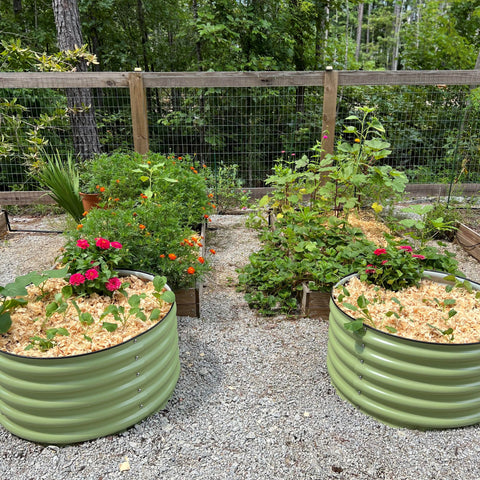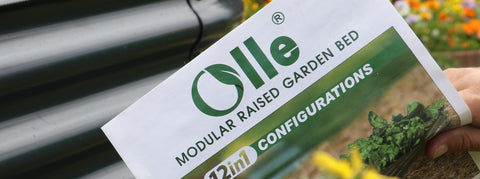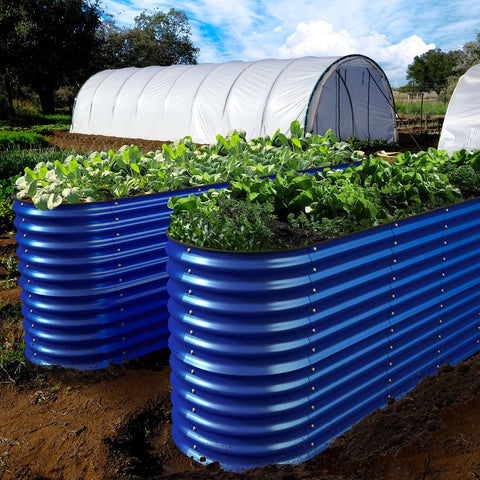Knowledge from Olle Garden Bed: Which Type of Root Cellar is Suitable for You?
Rootcellar is cool again (pun). With the development of modern refrigeration, the root cellar seems to be out of date. However, with people's renewed interest in gardening, food security and even sustainable life, the root cellar is back! The following are some advantages of storing rhizome vegetables in the root cellar, and several types of rhizome vegetables are introduced. The following content also has some reference value for raised garden beds.
Before refrigeration, the underground root cellar is an important way to store carrots, radishes, beets, parsnips, potatoes and other root vegetables. Today, the root cellar has made a comeback to prevent food from freezing in winter and keep food cool in summer to prevent deterioration.
What is root cellar?
Technically, the root cellar is any storage location that uses the earth's natural cooling, insulation and humidification characteristics. Whether you store your own agricultural products in the root cellar or the bounty from the local farmers' market, this is a proven storage method.
Rhizome vegetables, such as carrots, potatoes, beets, parsnips, turnips and radishes, are usually stored in the root cellar. This environment is very suitable for storing canned or pickled vegetables and bulbs or rhizomes of perennial flowers. The secondary use of the root cellar is as a place to store wine, beer or other home-made alcoholic beverages.
Advantages of root cellar
Although the purchase price of rhizome vegetables is not expensive, the quality of self-produced potatoes or beets is much better, and the grocery store does not always have vegetables all year round (or the vegetables you buy are not in the season and are not very delicious! Having a root cellar is like having six months of high-quality vegetables on hand.
In addition, it is reassuring to have enough food security without being manipulated by the grocery store and potential interruption of the supply chain.
Finally, there is another advantage that you do not have to pay such a high electricity bill to refrigerate or cool the product, because the ground temperature will naturally do this for you.
Root Pit Requirements
For proper operation, the root cellar must be able to maintain a temperature of 32 º to 40 º F (0 ° to 4.5 ° C) and a humidity level of 85% to 95%. This means that the root cellar may not be able to work in the warm southern climate.
The cool temperature slows down the release of ethylene gas from crops and prevents the growth of microorganisms, thus slowing down the ripening and decomposition.
High humidity levels prevent moisture loss due to evaporation and the resulting wilting appearance.
Please consult your local building department to find out what legal requirements you may need to comply with before carrying out any construction.
Consider your location. The root cellar cannot be built in the place where the groundwater level is high or there is a septic tank system nearby. In addition, you need a location that is close and easy to access. Some people build them under garden sheds, so they don't have to clear snow in winter to enter it.
You will need a design that allows you to control humidity, temperature, ventilation, and drainage. These will affect how long you can store the product.
Type of root cellar
Basement root cellar
Today, the root cellar is usually connected to the house for easy access, although creating a cold basement corner may require some effort.
The best way is to use the foundation wall in the northeast corner as both sides of the root cellar.
Build two more walls in the basement with studs and boards.
Insulate interior walls, ceilings, and doors (and any pipes or ducts) to prevent heat from entering.
Ensure that there is a ventilation system that allows cool fresh air to be brought into the root cellar from the outside and old air to be discharged. This helps prevent mold and mildew.
cellar
Another option outside the house is to dig down into the ground or horizontally into the hillside.
This option requires good drainage; Sandy soil is better. Elevated slopes will help because water will flow away from your pit as it moves down.
If your winter temperature drops below 25 ° F (- 4 ° C), dig your pit deep enough so that all crops are below the soil surface.
When you dig a hole in the ground, open both sides to prevent it from collapsing.
Line up the hole with straw and dry leaves, cover the hole with thick wood, and cover the cover with soil.
trash can
In winter, the use of metal trash cans or buckets in holes in the cellar helps prevent water from entering.
Dig a hole slightly larger than the diameter of the trash can and deep enough so that the lid is 4 inches above the soil level.
Pile soil around the circumference, add straw and crops to the jar, and cover the lid with straw or mulch and a piece of plastic to keep everything dry.
Rhizome vegetables can be stored well even in the coldest weather.

How to keep the root cellar cool
In order to create the best atmosphere in your root cellar, please consider the following tips:
Complete temperature stability is achieved at a depth of about 10 feet (3 meters).
Do not dig root cellars near big trees; The roots may be difficult to dig through, and they will eventually grow and break the cellar walls.
Inside, wooden shelves, dustbins and platforms are normal because wood does not transmit heat and cold as quickly as metal.
Air circulation is essential to minimize mold in the air, so the shelf should be 1 to 3 inches (3 to 8 cm) away from the wall.
For outdoor root cellars, fill soil is the preferred floor. The concrete effect is very good and practical for the basement cellar.
Each root cellar requires a thermometer and a hygrometer (to measure temperature and humidity respectively), which should be checked daily if possible.
Heat is usually regulated by external ventilation or exhaust pipes - usually cold air is allowed in, usually lowering the temperature on autumn nights.
10 Tips for Storing Harvest
Store your root cellar as late as possible. If possible, cool the product in the refrigerator before placing it in the cellar.
Some vegetables such as potatoes, wax gourds, pumpkins and onions need to be "pickled" at warm temperatures for several days before they can be stored. Learn how to treat pumpkins and pumpkins.
Shake off loose dirt, not wash it off. Many root cellar vegetables are better stored in this way, and getting them wet will promote decay. Carrots and beets are particularly easy to store: just brush off loose dirt, clip the leaves back about an inch above the roots, and store the roots in a damp sand or peat moss box.
Always handle vegetables with care; Even a slightly rough treatment will lead to invisible bruises, which will start the product on the road of decomposition.
Store cabbage and radish in a separate root cellar so that their smell (which may be unpleasant) does not penetrate the house.
Think about where you put your produce: the driest and warmest air is near the ceiling, the wetter air is lower, and the door is farthest away. Check out our page about storing crops without a root cellar to see which vegetables like which conditions.
Most fruits "breathe", and some fruits - especially apples and pears - should be wrapped with paper to slow the release of ethylene gas, which may lead to deterioration of other agricultural products.
It is not recommended to make root cellars or use pressure treated wood in garages.

Vegetables piled together will generate heat, which will lead to deterioration. Place vegetables on a shelf near the floor and rotate the shelf at regular intervals.
Check your vegetables regularly and immediately remove any vegetables that show signs of decay. From the lesson of Rootcellar, we can draw the following sentence: "One rotten apple will destroy the whole barrel!
Whether you harvest agricultural products yourself or buy them at the local farmers' market, you can try these technologies!
